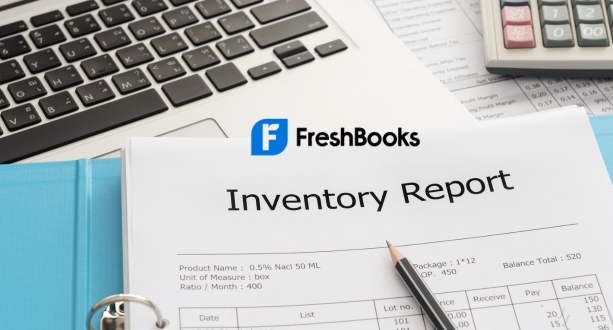Introduction
Mastering Efficiency: The Crucial Role of FreshBooks in Inventory Management
In the fast-paced landscape of business, the efficient management of inventory stands as a cornerstone for success. This section delves into the paramount importance of streamlined inventory processes and highlights the pivotal role played by FreshBooks in optimizing these critical operations.
Importance of Efficient Inventory Management
Efficient inventory management is not merely a logistical necessity but a strategic imperative. It entails the seamless orchestration of stock levels, order processing, and data analysis to meet customer demands, minimize costs, and enhance overall business performance. Proper inventory management serves as a linchpin for sustaining profitability and customer satisfaction.
Role of FreshBooks in Streamlining Inventory Processes
- Real-Time Inventory Tracking:
FreshBooks empowers businesses with real-time inventory tracking, allowing for accurate monitoring of stock levels. This feature minimizes the risk of stockouts or overstock situations, ensuring that businesses can meet customer demands efficiently.
- Automated Order Processing:
The platform facilitates automated order processing, streamlining the creation of orders and generation of invoices. This not only enhances the speed of transactions but also reduces the likelihood of errors associated with manual order handling.
- Comprehensive Reporting and Data Analysis:
FreshBooks provides robust reporting tools for in-depth data analysis. Businesses can extract valuable insights from inventory reports, aiding in informed decision-making. This analytical capability is instrumental in optimizing stock levels and identifying trends in consumer behavior.
- Integration with E-commerce Platforms:
Seamless integration with e-commerce platforms ensures a cohesive flow of data between online stores and inventory management. This integration enhances order processing efficiency and minimizes the chances of discrepancies between online and offline inventory records.
In conclusion, the efficient management of inventory is pivotal for businesses seeking sustained growth and competitiveness. FreshBooks, with its array of features and capabilities, emerges as a reliable ally in this journey. By streamlining inventory processes, providing real-time insights, and integrating seamlessly with e-commerce platforms, FreshBooks becomes an indispensable tool for businesses aiming to master the art of efficient inventory management. As we delve deeper into the intricacies of FreshBooks‘ inventory module, the focus will shift towards practical tips, optimization strategies, and addressing common challenges in the dynamic realm of inventory management.
Unveiling the Core: Exploring Key Components of FreshBooks Inventory Module
The heart of efficient inventory management lies in the robust features offered by FreshBooks. This section meticulously dissects the key components of FreshBooks’ Inventory Module, illuminating the processes involved in product setup, inventory tracking, and supplier management.
Product Setup and Categorization
- Adding and Organizing Products in FreshBooks:
Delve into the step-by-step process of adding products to FreshBooks, ensuring clarity and accuracy in the cataloging process.
Explore the intuitive features that facilitate easy organization, helping businesses create a well-structured and easily accessible product database.
- Utilizing Categories for Efficient Cataloging:
Uncover the benefits of categorizing products within FreshBooks, allowing businesses to create a logical and user-friendly catalog.
Understand how efficient categorization simplifies inventory searches, enhances user experience, and contributes to streamlined inventory processes.
Inventory Tracking and Real-Time Updates
- Setting Up Inventory Tracking Features:
Navigate through FreshBooks’ inventory tracking setup, ensuring businesses can monitor stock levels with precision.
Explore customizable features that cater to various business models, providing flexibility in tracking inventory for diverse products.
- Benefits of Real-Time Inventory Updates:
Uncover the advantages of real-time inventory updates, elucidating how businesses can make informed decisions based on up-to-the-minute stock information.
Highlight the impact of real-time updates on order fulfillment, preventing stockouts or overstock situations and fostering customer satisfaction.
Keywords: Real-Time Inventory Tracking, FreshBooks Updates
Supplier Management and Automated Reordering
- Managing Suppliers in FreshBooks:
Explore the supplier management features within FreshBooks, emphasizing the importance of maintaining accurate supplier information for seamless transactions.
Understand how businesses can leverage supplier data for better negotiation, order processing, and building strong vendor relationships.
- Implementing Automated Reordering Systems:
Delve into the automation capabilities FreshBooks offers for reordering, reducing manual efforts and minimizing the risk of stockouts.
Highlight the efficiency gains achieved through automated reordering, allowing businesses to maintain optimal stock levels without constant manual oversight.
In conclusion, the key components of FreshBooks’ Inventory Module serve as the foundation for a well-organized and efficient inventory management system. Businesses can capitalize on these features to streamline product setup, ensure real-time tracking, manage suppliers effectively, and implement automated reordering. As we progress through the guide, the focus will shift towards leveraging these components for efficient order processing, optimizing inventory, and addressing common challenges in the dynamic landscape of inventory management.
Orchestrating Success: Efficient Order Processing with FreshBooks Inventory
In the intricate dance of commerce, efficient order processing emerges as a key choreography, and FreshBooks takes center stage with its robust Inventory Module. This section delves into the nuanced art of order creation, invoicing, the seamless integration with e-commerce platforms, and the strategic power of data analysis for informed decision-making.
A. Order Creation and Invoicing
- Creating Orders Seamlessly in FreshBooks:
The process of creating orders within FreshBooks is akin to composing a symphony of precision. Users navigate an intuitive interface, inputting crucial details to ensure accurate and error-free order creation. This step-by-step guide illuminates the path, emphasizing the pivotal role of precise order creation in maintaining meticulous inventory records and meeting customer expectations seamlessly.
- Generating Invoices for Efficient Billing:
In the realm of invoicing, FreshBooks orchestrates an efficient billing symphony. The invoicing process unfolds effortlessly, with features designed to enhance speed, accuracy, and customer satisfaction. We explore the intricacies of this process, spotlighting how streamlined invoicing contributes to a harmonious order-to-cash cycle, fostering positive and enduring customer relationships.
B. Integration with E-commerce Platforms
- Seamless Connection with E-commerce Systems:
The integration of FreshBooks with e-commerce platforms is akin to creating a seamless connection between different sections of an orchestra. We uncover the advantages of this integration, showcasing how it eliminates the dissonance of manual data entry and reduces the risk of errors. The result is a harmonized workflow that enhances the efficiency of order processing and ensures a synchronized view of inventory data across platforms.
- Streamlining Order Processing Through Integration:
The integration process unfolds as a harmonious melody, illustrating the simplicity and effectiveness of connecting FreshBooks with e-commerce systems. This section emphasizes the transformative impact on the entire order processing workflow. By eradicating manual data silos and fostering a unified view of inventory, businesses can amplify their efficiency in handling orders with precision and speed.
C. Inventory Reports and Data Analysis
- Accessing Comprehensive Inventory Reports:
Navigating the expanse of FreshBooks’ reporting tools is akin to exploring a rich musical composition. Users gain access to detailed inventory reports offering a panoramic view of stock levels, sales, and trends. This exploration unfolds the depth of insights provided by these reports, empowering businesses with the knowledge to make informed decisions and optimize their inventory strategies.
- Analyzing Data for Informed Decision-Making:
The strategic role of data analysis emerges as a crescendo in the symphony of inventory management. This section accentuates the pivotal role of FreshBooks’ reporting tools in enabling businesses to analyze data. Concrete scenarios illustrate how such analysis can lead to inventory optimization, strategic planning, and a harmonious orchestration of resources.
In conclusion, the art of efficient order processing is a multifaceted symphony, and FreshBooks’ Inventory Module stands as a conductor guiding businesses through the intricacies of this performance. As we traverse the guide, the spotlight will shift towards refining inventory management, addressing common challenges, and fortifying security measures within the dynamic landscape of inventory processing.
Fine-Tuning Success: Inventory Optimization and Cost Control with FreshBooks
In the intricate ballet of inventory management, achieving optimal stock levels and implementing effective cost control measures are the graceful pirouettes that lead to sustained success. This section gracefully unravels strategies for maintaining stock equilibrium and cost-effective practices, all while leveraging the powerful tools provided by FreshBooks.
A. Optimizing Stock Levels
- Strategies for Maintaining Optimal Stock Levels:
- Delve into a nuanced exploration of strategies for maintaining optimal stock levels, emphasizing the delicate balance between demand and supply.
- Highlight the significance of forecasting, historical data analysis, and market trends in crafting a strategy that prevents stock outs or overstock situations.
- Utilizing FreshBooks Tools for Optimization:
- Uncover the suite of tools within FreshBooks designed to optimize stock levels seamlessly.
- Illustrate how features such as real-time inventory tracking, automated reordering, and comprehensive reporting contribute to a dynamic optimization strategy.
B. Cost Control Measures
- Implementing Cost-Effective Inventory Practices:
- Navigate through the implementation of cost-effective inventory practices, elucidating methods to minimize expenses without compromising on product quality or customer satisfaction.
- Showcase the importance of efficient supplier negotiations, bulk purchasing strategies, and lean inventory practices in controlling costs.
- FreshBooks Features for Cost Management:
- Unveil the arsenal of features within FreshBooks crafted to manage and control inventory costs effectively.
- Illustrate how tools such as real-time expense tracking, supplier management, and automated reordering contribute to creating a cost-efficient inventory ecosystem.
In conclusion, the symphony of inventory management reaches its crescendo through the delicate ballet of optimization and cost control. FreshBooks, with its array of tools and features, provides the virtuoso performance necessary for businesses to achieve equilibrium in stock levels while implementing judicious cost control measures. As we progress through the guide, the spotlight will shift towards crafting efficient invoicing strategies, addressing challenges in inventory management, and unlocking the potential of seamless integration with e-commerce platforms.
Setting Up Your Inventory System: A Comprehensive Guide
Establishing a robust inventory system is the cornerstone of effective business operations. This section unveils the essential steps in setting up your inventory using FreshBooks, from adding items to tracking inventory levels in real-time, and even managing inventory across multiple locations.
Adding Items to Your Inventory
Process of Adding New Items:
- Navigate to Inventory Module:
Begin by accessing the Inventory Module within FreshBooks. This intuitive interface serves as the command center for all your inventory-related activities.
- Select “Add Item”:
Click on the “Add Item” button to initiate the process of adding a new item to your inventory. This action will prompt a form where you can input all relevant details.
- Enter Product Details:
Populate the form with essential product details, such as product name, category, and any specific attributes. This step ensures a comprehensive and organized inventory catalog.
- Add Descriptions:
Provide detailed descriptions for each item, aiding both internal understanding and customer-facing clarity. Clear descriptions contribute to efficient tracking and communication.
- Assign SKUs:
Assign unique Stock Keeping Units (SKUs) to each item. SKUs serve as distinct identifiers, streamlining the tracking process and preventing confusion, especially in a growing inventory.
- Upload Images:
Enhance the visual appeal and identification of your items by uploading images. Visual representations contribute to accurate identification, reducing the likelihood of errors.
- Specify Cost Prices:
Input the cost prices for each item. This information is pivotal for tracking expenses, calculating profit margins, and making informed pricing decisions.
Tracking Inventory Levels
Guide on Tracking Inventory Levels in Real-Time:
- Utilize Real-Time Inventory Tracking:
Leverage FreshBooks’ real-time inventory tracking feature to monitor stock levels dynamically. This ensures that you always have accurate insights into your current inventory status.
- Set Reorder Points:
Establish reorder points for each item based on historical data, sales patterns, and lead times. Reorder points trigger timely replenishment, preventing stockouts and ensuring seamless business operations.
- Receive Automatic Low-Stock Notifications:
Activate automatic low-stock notifications within FreshBooks. This feature proactively alerts you when inventory levels hit specified thresholds, enabling swift action to avoid disruptions in supply chains.
Multi-Location Inventory Management (Optional)
Managing Inventory Across Multiple Locations and Warehouses:
- Access Multi-Location Features (if applicable):
If your business operates across multiple locations or warehouses, explore FreshBooks’ optional multi-location inventory management features.
- Allocate Stock to Respective Locations:
Allocate stock to specific locations or warehouses within the system. This ensures accurate tracking of inventory movements and prevents confusion in a distributed setup.
- Coordinate Reordering Across Locations:
Streamline the reordering process by coordinating it seamlessly across multiple locations. This fosters an integrated and synchronized approach to inventory replenishment.
In conclusion, setting up your inventory system with FreshBooks is a meticulous process that lays the foundation for efficient business operations. From adding items with detailed information to tracking inventory levels in real-time and optionally managing across multiple locations, FreshBooks provides the tools to orchestrate a harmonious inventory management system. As we progress through the guide, the spotlight will shift towards invoicing strategies, cost-effective practices, and addressing common challenges in inventory management.
Mastering Inventory Transactions: Navigating the Complex Symphony
In the intricate ballet of inventory management, mastering transactions is akin to orchestrating a complex symphony. This section unveils the harmonious process within FreshBooks, guiding you through recording purchases and sales, handling returns and refunds, and making adjustments for scenarios like shrinkage, damage, and loss.
Purchases and Sales
Recording Purchase Orders, Invoices, and Sales Orders:
- Initiating Purchase Orders:
Start by recording your purchase orders within FreshBooks. Navigate to the Purchase Order section, input vendor details, item quantities, and agreed-upon terms.
- Invoicing for Purchases:
Once the goods are received, seamlessly convert purchase orders into invoices. This process automates the update of inventory levels and the cost of goods sold (COGS) in real-time.
- Handling Sales Orders:
Similarly, for sales transactions, create sales orders specifying customer details, ordered items, and terms. As you fulfill the orders, convert them into invoices, facilitating a smooth sales process.
- Automatic Inventory and COGS Updates:
FreshBooks automates the update of inventory levels and cost of goods sold (COGS) as you record purchase orders, invoices, and sales orders. This real-time synchronization ensures accurate financial records and inventory tracking.
Returns and Refunds
Handling Returns and Refunds:
- Initiating Return Transactions:
Guide readers on how to initiate return transactions within FreshBooks. This involves accessing the system, locating the original transaction, and specifying the items being returned.
- Adjusting Inventory Levels:
As returns are processed, inventory levels are automatically adjusted within FreshBooks. This step ensures that the system reflects the accurate quantity of items on hand.
- Ensuring Accurate Financial Records:
Emphasize the importance of handling returns accurately for financial record-keeping. FreshBooks ensures that corresponding adjustments are made to the cost of goods sold (COGS) and revenue, maintaining financial integrity.
Inventory Adjustments
Addressing Scenarios like Shrinkage, Damage, and Loss:
- Scenario-Specific Adjustments:
Cover scenarios such as shrinkage, damage, or loss, explaining how to initiate adjustments within FreshBooks. This step involves accessing the Inventory Adjustment feature.
- Adjusting Quantities and Values:
Demonstrate the process of adjusting both quantities and values for items affected by shrinkage, damage, or loss. This ensures that inventory levels align with the physical reality of the business.
- Maintaining Accuracy in Inventory Records:
Conclude by highlighting the significance of timely adjustments in maintaining accurate inventory records. FreshBooks serves as a tool to align financial records with the actual state of inventory.
In conclusion, mastering inventory transactions within FreshBooks involves navigating the complexities of purchases, sales, returns, and adjustments. By seamlessly recording transactions, handling returns and refunds accurately, and making adjustments for specific scenarios, businesses can maintain a harmonious and accurate inventory management system. As we proceed through the guide, the focus will shift towards advanced features, optimizing inventory processes, and enhancing the overall efficiency of inventory management.
Optimizing Inventory Processes: The Art of Efficiency
In the dynamic landscape of inventory management, optimization is the key to unlocking efficiency and ensuring the seamless flow of operations. This section delves into the strategies within FreshBooks to optimize inventory processes, utilizing robust reports, automating recurring tasks, and leveraging integrations for enhanced workflow.
Inventory Reports and Insights
Exploring Various Reports in FreshBooks:
- Sales Reports:
- Guide readers on accessing and interpreting sales reports within FreshBooks. These reports provide insights into product performance, customer preferences, and revenue trends.
- Showcase how analyzing sales reports aids in identifying top-selling items, optimizing marketing strategies, and making data-driven decisions.
- Stock Reports:
- Unveil the significance of stock reports, detailing current inventory levels, sales velocity, and product turnover rates.
- Illustrate how stock reports assist businesses in maintaining optimal stock levels, preventing stock outs or overstocks, and fostering a healthy cash flow.
- Reorder Point Reports:
- Explore the functionality of reorder point reports, emphasizing their role in proactive inventory management.
- Guide users on setting appropriate reorder points based on historical data and sales patterns, ensuring timely replenishment and preventing disruptions.
- Informed Decision-Making:
- Emphasize how leveraging these reports collectively empowers businesses to make informed decisions regarding stock levels, pricing strategies, and future inventory investments.
Automate Inventory Tasks
Showcasing Automation of Recurring Tasks:
- Purchase Order Creation:
- Showcase how FreshBooks allows businesses to automate the creation of purchase orders based on predefined reorder points.
- Highlight the time-saving benefits and the accuracy achieved through automating this recurring task, reducing the risk of oversight.
- Low-Stock Alerts:
- Guide readers on setting up automated low-stock alerts within FreshBooks. These alerts trigger notifications when inventory levels reach specified thresholds.
- Illustrate how this automation ensures proactive management by alerting teams to impending stock shortages, enabling timely action.
- Time-Saving and Accuracy:
- Emphasize the dual benefits of automation—saving time on manual tasks and enhancing accuracy by minimizing human error.
- Conclude by reinforcing how automation contributes to a more efficient and responsive inventory management system.
FreshBooks Integrations for Inventory
Highlighting Integrations with E-commerce Platforms, Accounting Software, and
Barcode Scanners:
- E-commerce Platforms:
- Showcase the seamless integration capabilities with popular e-commerce platforms, facilitating the synchronization of sales data, customer information, and inventory levels.
- Illustrate how this integration streamlines order processing, reducing manual data entry and enhancing overall efficiency.
- Accounting Software:
- Highlight the integration with accounting software, emphasizing the cohesive flow of financial data between inventory and accounting modules.
- Demonstrate how this integration eliminates silos, fostering a holistic view of business operations.
- Barcode Scanners:
- Introduce the integration with barcode scanners, streamlining the process of tracking and managing inventory levels.
- Showcase the efficiency gains achieved through real-time scanning, reducing the likelihood of errors associated with manual data entry.
In conclusion, optimizing inventory processes within FreshBooks involves harnessing the power of robust reports, automating recurring tasks, and leveraging integrations for enhanced workflow. As we progress through the guide, the focus will shift towards addressing common challenges in inventory management, ensuring security in multi-currency transactions, and providing a comprehensive conclusion to the overall inventory management guide.
Advanced Inventory Management Strategies: Mastering the Art
In the realm of inventory management, mastering advanced strategies is the key to achieving precision, efficiency, and optimal resource allocation. This section delves into three advanced techniques within FreshBooks—Inventory Forecasting, ABC Analysis, and Inventory Cycle Counts.
Inventory Forecasting
Techniques for Forecasting Future Demand:
- Data-Driven Forecasting:
- Advocate for the utilization of historical sales data, market trends, and seasonality patterns to predict future demand accurately.
- Emphasize the role of data-driven forecasting in optimizing inventory levels, preventing both overstocking and understocking scenarios.
- Predictive Analytics:
- Introduce the concept of predictive analytics within FreshBooks, showcasing its ability to analyze patterns and make proactive predictions.
- Guide businesses on leveraging predictive analytics to align their inventory with anticipated demand, fostering a responsive supply chain.
ABC Analysis
Prioritizing Inventory Based on Importance and Value:
- Identification of High-Impact Items:
- Explain the ABC Analysis methodology, categorizing inventory into three groups—A, B, and C—based on their importance and value.
- Showcase how this classification allows businesses to focus resources and attention on high-impact items that significantly contribute to revenue.
- Resource Optimization:
- Illustrate how prioritizing inventory enables efficient resource allocation, preventing unnecessary investment in low-impact items.
- Guide readers on how FreshBooks facilitates the categorization and ongoing management of items based on their ABC classification.
Inventory Cycle Counts
Conducting Regular Cycle Counts for Accuracy:
- Frequency and Purpose:
- Advocate for the regularity of inventory cycle counts, emphasizing their role in maintaining accuracy and identifying discrepancies promptly.
- Guide businesses on how to integrate cycle counts seamlessly into their operational routine within FreshBooks.
- Proactive Discrepancy Resolution:
- Highlight the proactive nature of cycle counts in identifying discrepancies before they escalate, ensuring that inventory records align with the physical inventory on hand.
- Illustrate how businesses can use FreshBooks to streamline the cycle count process and maintain an accurate and reliable inventory system.
In conclusion, these advanced inventory management strategies within FreshBooks—Inventory Forecasting, ABC Analysis, and Inventory Cycle Counts—elevate businesses to a level of precision and responsiveness in their supply chain operations. As we conclude this guide, the final section will provide insights into ensuring security in multi-currency transactions and delivering a comprehensive overview of the entire inventory management journey.
Enhancing Security in Inventory Management with FreshBooks: Safeguarding Your Data
In the digital landscape, safeguarding sensitive inventory data is paramount. FreshBooks ensures the highest standards of security, prioritizing the protection of your valuable information.
- Secure Data Handling and Storage:
FreshBooks employs robust encryption protocols, guaranteeing the secure handling and storage of your inventory data. This safeguards against unauthorized access and ensures the confidentiality of crucial business information.
- FreshBooks Security Features for Inventory:
Benefit from FreshBooks’ comprehensive security features specifically designed for inventory management. These measures encompass secure access controls, routine security audits, and proactive threat detection, fortifying your inventory system against potential vulnerabilities.
Rest easy as FreshBooks prioritizes the integrity and confidentiality of your inventory data, allowing you to focus on your business’s growth without compromising security.
Conclusion: Navigating Success with FreshBooks Inventory Management
Embarking on the journey of inventory management with FreshBooks has been a transformative experience, elevating your business’s operational efficiency and financial prowess. Throughout this guide, we’ve explored the essential components of FreshBooks inventory management, from setting up your system and mastering transactions to optimizing processes and embracing advanced strategies.
As you navigate the dynamic landscape of inventory management, FreshBooks serves as your steadfast companion, offering robust features, intuitive interfaces, and advanced tools. From efficient order processing and inventory optimization to automation and seamless integration with e-commerce platforms, FreshBooks has empowered you to streamline operations and make data-driven decisions.
The guide delved into advanced techniques such as inventory forecasting, ABC analysis, and cycle counts, providing a comprehensive toolkit for businesses aiming for precision and success. We emphasized the importance of security in the digital realm, showcasing FreshBooks’ commitment to data protection and secure inventory management.
In conclusion, your journey with FreshBooks goes beyond mere inventory control; it’s about orchestrating a symphony of efficiency, accuracy, and growth. As you implement the insights gained from this guide, your business is poised not just to manage inventory but to thrive in a competitive landscape, ensuring lasting success and prosperity.









